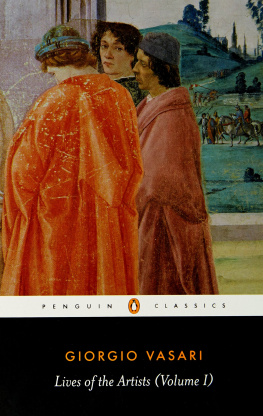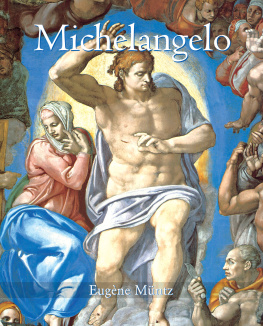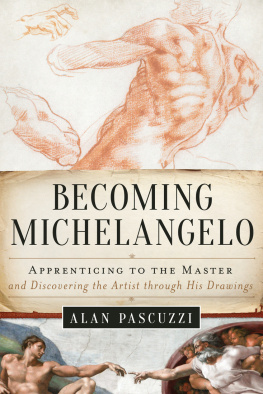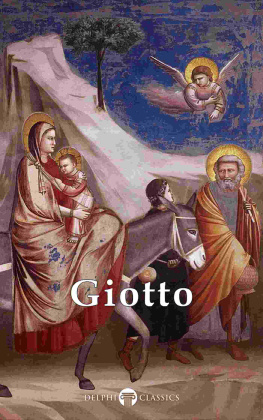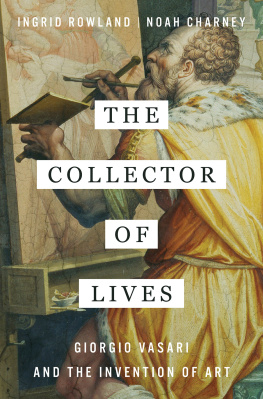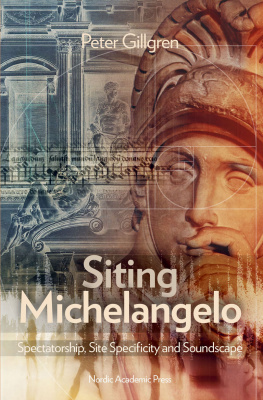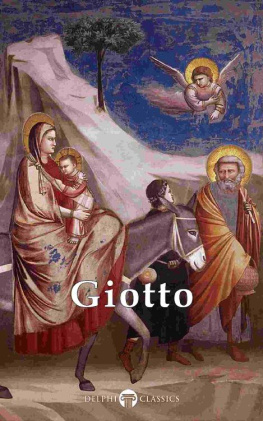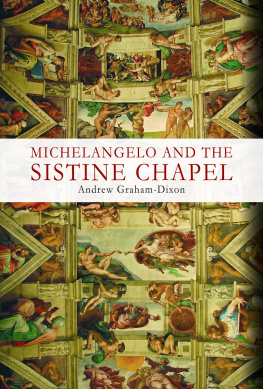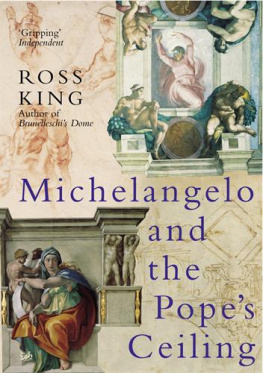
LIVES OF THE ARTISTS
VOLUME I
GIORGIO VASARI was born in 1511 at Arezzo in Tuscany. While still a boy he was introduced to Cardinal Silvio Passerini who put him to study in Florence with Michelangelo who later became a close friend then with Andrea del Sarto. He left Florence when his patron, Duke Alessandro, was assassinated, and wandered round Italy filling his notebooks with sketches; it was during this period that he conceived the idea of the Lives. By now, in his thirties, Vasari was a highly successful painter and when his Lives were published they were received enthusiastically. He returned to Florence in 1555 to serve Duke Cosimo, who appointed him architect of the Palazzo Vecchio. After a grand tour of Italian towns he published the revised and enlarged edition of his Lives in 1568. Vasari spent the rest of his life in a glow of self-satisfaction and public recognition, and in 1571 he was knighted by Pope Pius V. He died in 1574.
GEORGE BULL was an author and journalist who translated six volumes for Penguin Classics: Benvenuto Cellinis Autobiography, The Book of the Courtier by Castiglione, Vasaris Lives of the Artists (two volumes), The Prince by Machiavelli and Pietro Aretinos Selected Letters, as well as Aretinos The Stablemaster in Five Italian Renaissance Comedies. After reading History at Brasenose College, Oxford, George Bull worked for the Financial Times, Mc Graw-Hill World News, and for the Director magazine, of which he was Editor-in-Chief until 1984. He was appointed Director of the Anglo-Japanese Economic Institute in 1986. He was a director of Central Banking Publications and the founder and publisher of the quarterly publications Insight Japan and International Minds. His books include Vatican Politics; Bid for Power (with Anthony Vice), a history of take-over bids; Renaissance Italy, a book for children; Venice: The Most Triumphant City; Inside the Vatican; a translation from die Italian of The Pilgrim: The Travels of Pietro della Valle; and Michelangelo: A Biography (Penguin, 1996; St Martins Press NY, 1997). George Bull was elected a Fellow of the Royal Society of Literature in 1981 and a Vice-President of the British-Italian Society in 1994. He was awarded an OBE in 1990. George Bull was made Knight Commander of the Order of St Gregory in 1999, and awarded the Order of the Sacred Treasure, Gold Rays with Neck Ribbon (Japan) in 1999. He died on 6 April 2001.
GIORGIO VASARI
LIVES OF THE
ARTISTS
VOLUME I
A SELECTION TRANSLATED BY
GEORGE BULL
PENGUIN BOOKS
PENGUIN BOOKS
Published by the Penguin Group
Penguin Books Ltd, 80 Strand, London WC2R 0RL, England
Penguin Putnam Inc., 375 Hudson Street, New York, New York 10014, USA
Penguin Books Australia Ltd, 250 Camberwell Road, Camberwell, Victoria 3124, Australia
Penguin Books Canada Ltd, 10 Alcorn Avenue, Toronto, Ontario, Canada M4V 3B2
Penguin Books India (P) Ltd, 11 Community Centre, Panchsheel Park, New Delhi 110 017, India
Penguin Books (NZ) Ltd, Cnr Rosedale and Airborne Roads, Albany, Auckland, New Zealand
Penguin Books (South Africa) (Pty) Ltd, 24 Sturdee Avenue, Rosebank 2196, South Africa
Penguin Books Ltd, Registered Offices: 80 Strand, London WC2R 0RL, England
www.penguin.com
This translation first published as Lives of the Artists 1965
Reprinted with minor revisions 1971
Reprinted as Lives of the Artists: Volume I 1987
25
Copyright George Bull, 1965
All rights reserved
Except in the United States of America, this book is sold subject
to the condition that it shall not, by way of trade or otherwise, be lent,
re-sold, hired out, or otherwise circulated without the publishers
prior consent in any form of binding or cover other than that in
which it is published and without a similar condition including this
condition being imposed on the subsequent purchaser
CONTENTS
For Catherine and Jennifer
INTRODUCTION
VASARIS LIVES
IN the second edition of the Lives, which was seen through the press in Florence in 1568, Giorgio Vasari informed his fellow artists that of the large number of volumes printed of the first edition, eighteen years before, not one had been left on the booksellers hands. A best seller when they were first published four hundred years ago, his biographies of the artists of the Renaissance have over the centuries maintained both their wide popular appeal and their immense historical value.
Vasari was born in 1511 (about the time Henry VIII came to the throne of England) in Arezzo, a Tuscan town which was subject to the Republic of Florence. He was a year old when by force of Spanish arms the Medical family were restored to power in Florence (to rule there almost without interruption for over two hundred years). As he grew up the dynastic conflict between France and Spain, in which Florence became a pawn in the Spanish camp, was caught up in the shattering turmoil of the Reformation. When he died in his early sixties the Catholic world was busy on harsh internal reform and offensive military action against Protestant states and rulers. The city state of Florence had long since settled down to the paternal rule of a Medici duke. Still developing vigorously in the north of Europe, in Italy the ideas and attitudes of the Renaissance were being modified or reversed by an alien spirit in art and life.
Though a fairly pious Catholic and a fierce patriot, Vasari was not the slightest bit interested in the religious and political issues of his time: the faintest whiff of gunpowder or heresy was enough to send him running for cover. Like Uccello, murmuring about the beauties of perspective as his wife nagged him to come to bed, like his contemporary Benvenuto Cellini, a braver but not a better man, Vasari was obsessed by art: the pictures and plans he was pouring out himself, the products and performance of his fellow artists. Nevertheless, the Lives were shaped by the historical circumstances of sixteenth-century Italy: autocratic governments in Rome and Florence, a balance between freedom of movement and incipient censorship of thought, and a newly established role for the artist in society, partly servant to the court and the people and partly a professional answerable to himself and God alone.
At the end of the Lives Vasari included a Description of his own works. From this and from what he tells us elsewhere emerges an autobiography which is generally unexciting in itself but valuable for the light it throws on the genesis of the Lives.
He came of a family of tradesmen (the name Vasari derives from vasaro or vasaio, a potter) which had already given one famous name to art, that of Luca Signorelli, the cousin of Giorgios grandfather, who gave Giorgio some of his first lessons in drawing. His father, Antonio Vasari, was none too well off (Giorgio was the eldest son of a very big family) but tolerably well connected. He encouraged Giorgios talent for drawing (as a child, Giorgio copied all the good pictures to be found in the churches of Arezzo); then in 1524 he used a family connexion to give the boy his big chance, taking him along to pay his respects to Cardinal Silvio Passerini, who was passing through Arezzo on his way, as representative of the newly elected Medici Pope, Clement VII, to take over the government of Florence during the minority of Alessandro and Ippolito de Medici.

